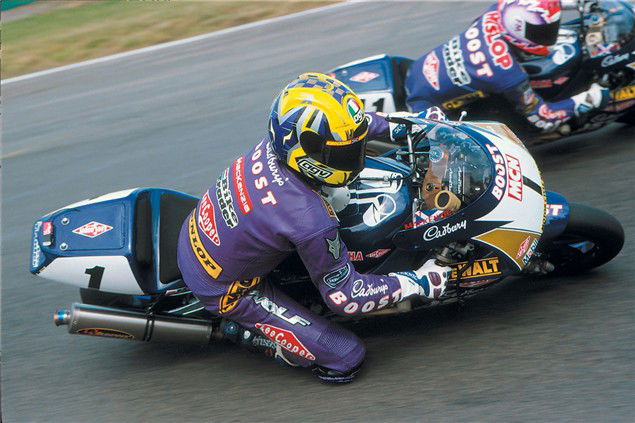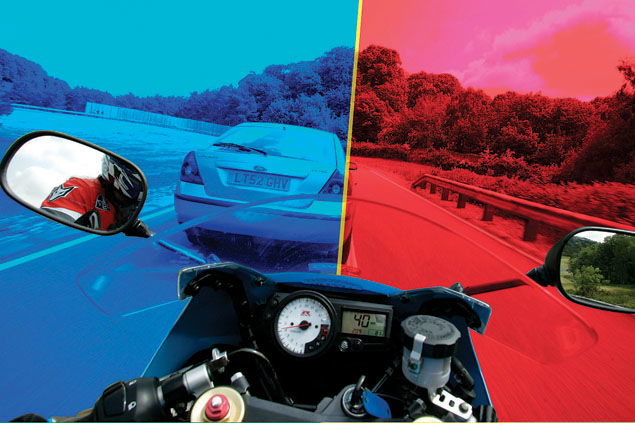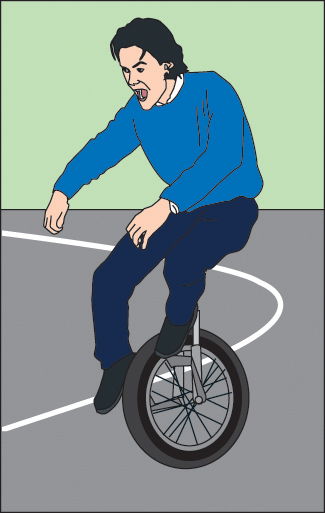Master Overtaking on the Track
Former top level racers, Niall Mackenzie and James Whitham both supervise their own track days. They know everything about overtaking on track...


The racing overtake
"Racing is all about overtaking. And while overtaking on the road is about accelerating, on the track it's more often about braking," says Niall Mackenzie.
We've looked at overtaking on the road, with safety top of the agenda. But most weekends we watch racers ride within millimetres of each other, brushing fairings and elbows as they overtake - hardly conducive to safe riding. But then, racing and road riding have as much in common as the brilliance of Zinedine Zidane and a Beckham spot kick.
The aim in racing is to get to that finish line before anyone else. "There are several lines round a corner," says James Whitham, "but there's only one fast line." Niall says this means racers are all fighting for the same six-inch piece of tarmac: "You always have to be careful your brake lever doesn't clip the other rider or you end up over the handlebars."
But, as they say, to finish first, first you have to finish. So isn't all this bashing of bike and body parts a bit too risky? "You can overtake this way in racing because you trust the person you're riding with," says Niall.
"You know exactly where they are and where they're going to be." James says it's easy to ride so close to people you race with at most meetings: "You're rarely riding with people you don't know - if you're in the first two rows, you're only ever going to be dicing with the same five or six riders. You know who they are and how they ride; you know each other's weaknesses, and you've got an idea even before you overtake where you're going to do it, because maybe you're better on the brakes and maybe they're on a quicker bike out of a certain corner. And because everyone's as quick as you are, you have to be aggressive."
Straight up the inside on the brakes is the most popular way to overtake in racing, according to both James and Niall. But because the guy in front is occupying the racing line, passing them automatically forces you off line, slowing you down. The chances are they'll get you back on the exit. So you do a block pass.
Block passing is a technique derived from motocross, where a rider accelerates going into a turn before the apex and slips his motorcycle on the inside of the leader, then quickly pivots to make the turn directly in front of him. This forces the rider being passed to brake because his line is blocked. James explains: "You get past any way you can on the brakes going into the corner. Once you get through, they won't be able to get you back mid-corner as you're blocking the way, so they're stuck behind you. Because you know you're about to block pass and be slow round the corner, you go in a gear lower to get a good punch out of the turn, preventing the guy you've just overtaken getting past you again on the way out. And because you've slowed him down mid-corner, he has no power coming out: he hasn't gone in a gear lower so he's driving off the bottom of the revs, while you just scream away. That's the plan."
THE RACING OVERTAKE EXPLAINED...
The block pass
Outbrake your rival and pass him on the inside, making sure you're in a gear lower. Park your bike on the apex to block their route, then power out while his bike's bogged down. He's toast!
Round the outside
You must be awesome for this one as it's the long way round. Simply outbrake your rival and ride round the outside - but you'll be off line so you'll get passed again easily on the exit.
Slipstreaming
On the straight, stay glued to the back of your rival's motorcycle, using the hole in the air his bike is creating to build speed, then pull out and pass him before the next corner. He's toast! Again!
Race overtaking cont.
Niall says Donington's Redgate is a good one for block passing: "Redgate is a third gear corner. So you overtake them on the brakes in second gear, block their route so they are forced to go round slow and consequently find themselves in too high a gear to slingshot their bike out of the corner, so you've got them.
With Redgate you need to be on line to be fast right the way through Craner Curves and beyond, so racers overtake extremely close. If you do find yourself on the wrong line, then you drift wide on the exit to stop the guy you've just passed from getting through again."
Both Niall and James hasten to add that block passing is a desperate racing manoeuvre. "If you do it every single corner of every lap, then everybody hates you," laughs James. "Ex-motocrosser Fabrizio Pirovano was a massive exponent of the block pass - you couldn't get him on the brakes because he went in so quick, you couldn't ride round him mid-corner because he was blocking the right line - but he was going 10mph slower than you wanted to go. Then he was in a gear lower so he opened the throttle and you couldn't get past him going out. It was like getting stuck behind a bloomin' tractor on a small B-road! He looked quick but his style was awkward."
People may not like block passes, but if it's the last lap you've got to do it. Valentino Rossi performed a classic block pass on Max Biaggi on his way to winning first time out on the Yamaha M1 at Welkom in 2004.
Diving under Biaggi's Honda into the penultimate right-hander, he forced Max to sit up, shut off and run off-line. And Niall is no stranger to these "last minute doings" either: "During the Oulton Park BSB round in 1998, Steve Hislop caught me with my pants down on the last corner, so I returned the compliment at the following round at Thruxton, block passing him at the last corner of the last lap. I tried it again at the next round at Snetterton, but instead managed to run us both off track. Hizzy was okay, but Rob McElnea was furious!"
You can also ride round the outside of someone in a corner, but it's the long way round. "You need to be awesome to ride round the outside of a fellow racer," says James. In his heyday, Kevin Schwantz pulled off some unbelievable overtakes. At the 1991 Donington GP round he rode round the outside of Wayne Rainey at the Melbourne Loop: "Now, riding round the outside is okay when you're club racing and you're much quicker than the other guy," explains James. "But Rainey's going as fast as he can on the racing line - which is just about as fast as anyone in the world can go - and Schwantz just rode round the outside!"
Earlier that year at the German GP, Schwantz passed Rainey on the last lap, missing his braking marker by a mile. A slipstreaming error, according to James and Niall...
If you watch racing you'll be aware of this technique. A lot of power goes into making a hole in the air to ride through and by tucking his bike close behind the bike in front, a racer can use the slipstream to make his bike go faster. He is, in fact, riding through the hole in the air the leading rider has made. "Earlier this year on the GSX-R750 launch, Schwantz and I were playing on track slipstreaming each other," says Niall.
"In the slipstream, top speed went from 290km to 299km! The effect is even stronger when you get behind two riders, and a rider being slipstreamed can feel the turbulence behind him."
Slipstreaming starts before the previous corner, explains James: "If you're right on someone's backside coming out of a corner, you'll be exiting at exactly the same speed. So to slipstream, you've got to build your speed by dropping back in the previous corner - this is dependent on not having someone behind you snapping at your heels because they'll have you - then firing out of it and having a good run at the man in front. So when you're in his slipstream you're actually already catching him up." Niall continues: "You then stay on his tail and as you approach the next corner, you use the momentum you've built up to pull out of the slipstream and pass them."
Circuits with long straights are best suited to the technique; James quotes Snetterton and even Brands as good slipstreaming tracks. But the old Hockenheim circuit was renowned for it. "The straight was so long there were two places you could slipstream," says Niall. "But pull out too early of a slipstreaming manoeuvre and the guy you're passing can get you back." And Hockenheim is where Schwantz made his historic move: "Schwantz would have got a good run out of that last chicane and slipstreamed Rainey along the straight. But he pulled out too late and missed his braking marker," says Niall. "It's easy to miss things when you're slipstreaming as you have a lot of things to think about - like trying not to run into the back of the other rider," says James. "I've missed chequered flags!" Schwantz still managed to wobble round, block Rainey and win the race.
Slipstreaming is risky, cautions Niall. You must have absolute trust in the other rider and even then, things can go wrong. Remember the 2001 BSB Rockingham round? Hizzy was right behind John Reynolds when JR missed a gear. Hizzy rammed into the back of him. The resulting crash lost Hizzy the championship.
Racers often follow a rider closely before overtaking to understand where they are stronger. And they often hold back until the last corners before making the move. "It's easier to follow than to lead," says Niall. "So you 'shadow' the lead rider until the last laps. By then, you know where you have the advantage so you can plan where and how to overtake - and there's not much time for them to get you back."

